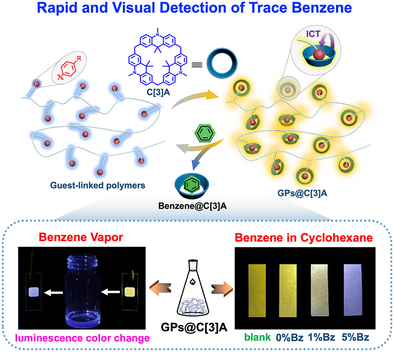Supramolecular TADF Materials from Calix[3]Acridan and Guest-Linked Polymers for Rapid and Visual Detection of Trace Benzene
Graphical Abstract
A new strategy for the rapid and visual detection of trace benzene was reported by utilizing supramolecular thermally activated delayed fluorescence polymeric materials GPs@C[3]A based on luminescence color change mechanism, and the limit of detection concentration for benzene vapor reached 3.5 mg L−1. Moreover, GP1@C[3]A was fabricated into a visualized and convenient paper-based sensor strip for detecting benzene in cyclohexane.
Abstract
In this work, a new strategy for rapid and visual detection of trace benzene vapor was reported by utilizing supramolecular thermally activated delayed fluorescence (STADF) polymeric materials via luminescence change mechanism. Consequently, a new type of multi-color STADF polymeric materials GPs@C[3]A were constructed by host–guest complexation between calix[3]acridan (C[3]A) and different guest-linked polymers (GPs). Interestingly, by adjusting the added molar proportion of C[3]A, multi-color TADF property of GPs@C[3]A could also be easily tuned. Notably, when a 20% molar ratio of C[3]A was added, GP1@C[3]A exhibited white luminescence. Especially, by using the high selectivity of C[3]A toward benzene and its differential binding affinities for acceptor guests versus benzene, rapid detection of trace benzene vapor was achieved in few seconds with the naked eyes. The limit of detection concentrations for benzene reached 3.5 mg L−1, indicating GPs@C[3]A could be used as an excellent sensor for rapid detection of benzene at trace level. Furthermore, GP1@C[3]A could also be fabricated into a visualized and convenient paper-based sensor strip for detecting benzene in cyclohexane. This work offers an innovative idea for the application of STADF materials in detection, and also addresses the key challenge of simultaneously improving sensitivity, selectivity and visualization in benzene detection.
Conflict of Interests
The authors declare no conflict of interest.
Open Research
Data Availability Statement
The data that support the findings of this study are available in the supplementary material of this article.





